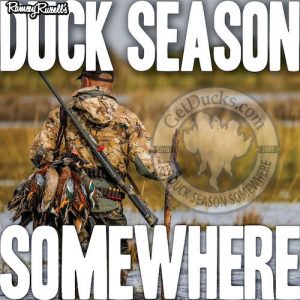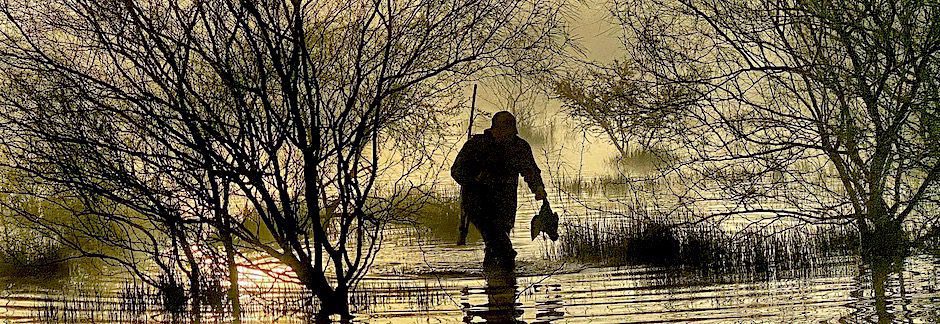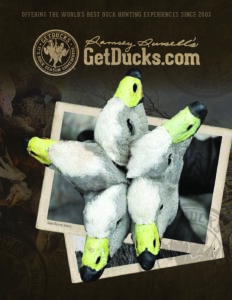MOJO’S Duck Season Somewhere Podcast
Jake Latendresse, Home Is Who You Are

On the heels of the Life’s Short GetDucks – Mississippi, Home Is Who You Are short film, Jake Latendresse and Ramsey catch up. They’ve shared an eventful friendship since first filming together in Australia. After globetrotting together worldwide, why did they resume productions with a Mississippi project? What hits home to them? How’s Mississippi relate to Azerbaijan duck hunting? What’s the back story on the old Colt hammer gun? And what kind of stuff does Jake really think about when he’s “in his bubble” behind the camera? This Duck Season Somewhere episode is about those traditional, non-disposable duck hunting values that remain forever timeless. Like Grand Dad’s cherished shotgun.
Watch Now: Life’s Short GetDucks: Mississippi, Home Is Who You Are
Jim Crews Mississippi Duck Camp

A roaring fire crackling on a cold january nights, swamp dogs tails are thumping at our feet, something good sizzles over hot charcoal nearby. We are whetting our appetites with toddies , listening to Mississippi Delta blues music. Swamp Warlock and Swamp Witch, Jim and Allison Crews, always cast wicked spells of southern hospitality. Tomorrow morning we’ll hunt Bobo Brake’s ancient, cathedral-like cypresses over traditional cork blocks, maybe even connecting with ancestral ghosts via an heirloom hammer-gun. But tonight we’re just enjoying each other’s company at duck camp. (Life’s Short GetDucks: Mississippi, Home Is Who You Are drops, May 25. Check it out on GetDucks YouTube channel).
Wetland Management for Waterfowl 3/3

The hot summer sun is beating down, water is off the site, and mud flats are greening with germinating moist-soil vegetation. What now? USDA-NRCS Wildlife Biologist Kevin Nelms walks through part-art-part-science solutions for producing desired moist-soil management results. What are suggested management practices for controlling undesirable plants? What early successional management practices set the stage for upcoming growing seasons? How can we kill 2 birds with one stone by combining the two? What’s Nelms’s rule-of-thumb for fall discing? What’s a waterfowl wetland complex? Why’s it important to know your property’s key habitat offerings relative to properties within a 12-mile radius? When and how best to flood waterfowl impoundments? What about hunting pressure?
Related Links:
Legendary Mississippi Bear Hunting Culture of Robert E. Bobo

Back in the early 1800s, the Mississippi Delta was a seething hardwood wilderness unrivaled by anything “until you reached the redwoods.” A Robert Eager Bobo and company plied their skills in that untamed environment, reputedly killing over 300 bears in a single year – plus a whole lot more. Who was Bobo, where’d he live? How’d they hunt bear back then? How famous were Bobo’s bear hounds? What weapon was preferred for bears in ancient canebrakes? Mississippi historian and outdoor writer, James McCafferty, and Ramsey Russell discuss these and other topics in today’s episode of Duck Season Somewhere podcast.
Wetland Management for Waterfowl 2/3

Did you know that mallard diet on the wintering grounds is predominately annual seeds? USDA-NRCS Wildlife Biologist, Kevin Nelms, and Ramsey Russell dig deeper into wetland habitat management for waterfowl subject. What are the 4 recognized wetland types and what life-cycle requirements do they each satisfy? Why will knowing these distinctions help you be a become a better waterfowl habitat manager and more successful duck hunter? What is foremost ingredient of managed wetlands increases both waterfowl utilization and hunt-ability? What are the pitfalls for planting rice for ducks? What is moist-soil management, what are the advantages, why’s it part-art and part-science, and what’s Nelms’s rule-of-thumb for perfect water drawdowns? We’re cooking in hot grease now!
Related Links:
Benelli Shotgun Innovations

George Thompson, Director of Product Management, Benelli USA gives Ramsey Russell an informative run-down of Benelli shotgun innovations. Benelli pioneered the inertia recoil system in 1967. Initially hitting US markets under H&K distribution, they have since come a long way. How has the Benelli Super Black Eagle shotgun evolved since the first? What features are stand out among other conventional waterfowl killing sticks? What drives the growing demand for sub-gauge chamberings? What is the new Benelli Surface Treatment about and how’d it originate? What about online rumors that SBE3 patterns high? Ramsey Russell and George Thomas discuss these topics in detail. Whether you’re a since-forever fan of Benelli shotguns like Ramsey, considering a new waterfowl shotgun purchase or simply curious, you’ll likely learn a few interesting things about why Benelli and Super Black Eagle shotguns are simply perfect.
Dale Bordelon, More Bayou Country Traditions

Dale Bordelon is a gifted storyteller from Avoyelles Parish, Louisiana. In last week’s episode (Episode 39, August 3, 2020, Dale Bordelon Bayou Traditions), Bordelon described gathering various local raw materials from nearby swamps, hand-making his Louisiana cane calls and other tools-of-the-trade as tribute to his roots; to Louisiana’s traditional waterfowling culture. In today’s Duck Season Somewhere podcast episode, we crawl belly deep into tepid, tea-colored swamp water. Bordelon describes trapping dinosaur-like alligator snappers the size of chest freezers, catching monster alligators, shooting old shotguns, blending duck blinds perfectly into the environment and more. Where’d Dale get the twine to wrap a special cane call he uses? How’d he catch those big, old snappers, what’d he do with them, and why did he quit? What’s his secret for catching BIG gators? Why does he like shooting pump shotguns from his grandad’s era? It’s another great episode depicting unvarnished Louisiana duck hunting culture.
Related Links:
Wetland Management for Waterfowl Habitat 1/3

Wetland management for better waterfowl habitat. Interested in wetland management for waterfowl (and I know from countless inbox requests for this topic that many of y’all are) then this 3-part series is right in your wheelhouse. It’s no accident that we’re dropping this series when it’s time to start readying your wetlands waterfowl habitat for next season! Regardless of where you hunt, better understanding duck habitat needs will make you a more successful hunter. As USDA Natural Resources Conservation Service’s Wildlife Biologist in the Mississippi Delta, Kevin Nelms is a duck hunter that has spent the past couple decades designing and developing numerous private-lands waterfowl impoundments pursuant to Wetland Reserve and other Farm Bill-related programs. He’s worked extensively with private landowners throughout the region, improving desirable duck habitat conditions, enhancing duck utilization, even putting together a handbook that Ramsey considers must-have staple for waterfowl habitat management (refer to related links in podcast description for your own PDF copy). In today’s Duck Season Somewhere podcast episode, Ramsey and Nelms make introductions then cannonball off the bow into murky subject matter, discussing prevailing silver-bullet misconceptions to waterfowl habitat management; duck life-cycle requirements on the wintering grounds; why recognizing and satisfying certain life-cycle requirements may attract more waterfowl; managing vegetative succession; the importance of invertebrates; and more.
Related Links:
“Damn at the Ducks!”

Mississippi native Alex Littlejohn remembers “Tallahatchie tree line duck hunting” with family members as a youngster after Canada geese ceased migrating to Mississippi. While in college, he guided duck hunts on South End Trails portion of Beaver Dam, the cypress oxbow lake made famous by Nash Buckingham, and worked at Wild Rose Kennels. What was it like hunting at Beaver Dam Lake, what are some of his favorite memories, and what do ducks do in lightening storms? What his most endearing memory of a favorite uncle that taught him to duck hunt and call ducks? And what happened in southwest Louisiana that made him wonder about predestination? Today’s Duck Season Somewhere podcast episode is a slow burn conversation, like two buddies sipping bourbon toddies during a rainy Mississippi duck hunting camp afternoon. All duck hunting listeners will relate.
Mama Duck Liz Bourgeois

“She’s probably banded more ducks than any non-biologist in North America,” said the mutual friend that introduced us. Liz Bourgeois grew up alongside 4 brothers, hunting the bayous of Avoyelles Parish, Louisiana. She was mentored by her father, who instilled in her a strong sense of conservation and unyielding independence. She now bands thousands of waterfowl annually, but finds purpose transferring those values to countless volunteers that know her only as a tireless fireball of enthusiastic energy. What does Liz recall about growing up hunting with her father? How’d she go from forensic accounting to waterfowl banding? What changes has she seen in Louisiana duck hunting, how’d her hunting background shape her wildlife technician skill-sets, and what interesting waterfowl behaviors has she learned learned while banding? Why’s it important to Liz that women have a sense of agency outdoors, and how does her facilitating hands-on waterfowl banding experiences ignite passion for wildlife? She’s the real deal, folks. Buckle up and grab the handle because she plows through this Duck Season Somewhere episode like only Mama Duck can!








